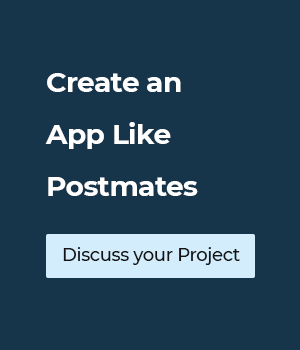The food delivery landscape has undergone major shifts. Due to transcending consumer behavior, online food delivery platforms are expanding convenience and choice, enabling customers to order easily, from a wide array of restaurants. One such food delivery platform is Postmates, which was recently acquired by Uber.
As a leader in the space of on-demand delivery, Postmates has established a strong foothold in the United States. Covered in this blog are insights into a fast-changing market, where building an app like Postmates may boost profitability.
Table of Contents:
What is Postmates?
Postmates is an on-demand food and goods delivery services company that was launched in 2011. It is a platform that acts as a unified continuum for customers, merchants, and independent workers (or “Postmates”), who interact with each other for on-demand delivery services.
Postmates is a three-sided marketplace. Each side uses the platform differently to meet their respective needs. In a nutshell, customers shop for food and other products. The order is received by the merchants, who use Postmates as a sales channel to find customers and grow their order volume. The fleet app is used by the courier staff to deliver orders to the customer’s door.
Due to the services offered, Postmates collaborated with big brands like, Apple, Chipotle, Starbucks, and more proving that its business model was strong. To learn how Postmates accelerated towards success by providing on-demand delivery services, let’s understand its business model.
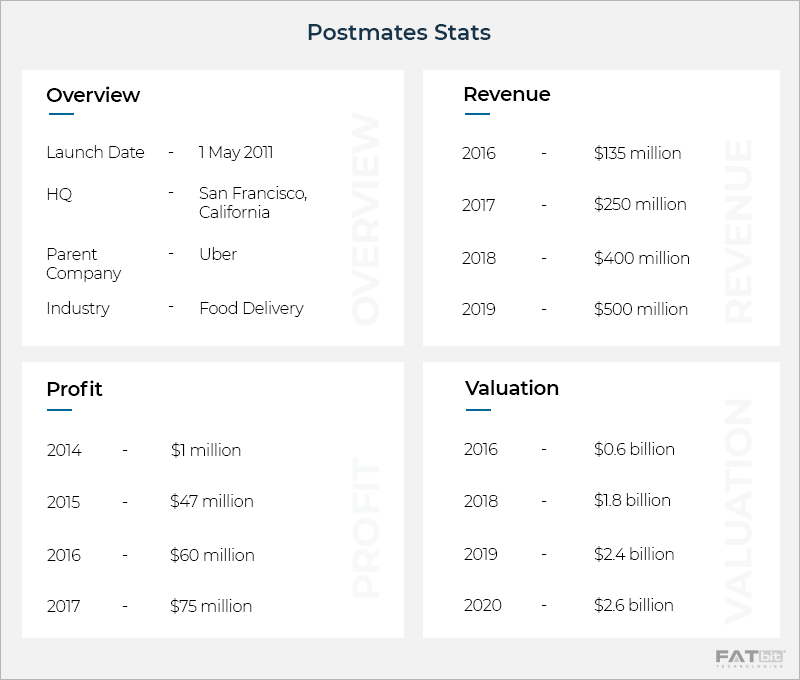 Source: Business of Apps
Source: Business of Apps
Understanding the Business Model of Postmates
The business model of Postmates is unique and has attracted several investors. It can be divided into 4 major steps. These are:
Browse Stores and Products
In the business model of Postmates, the first step is about creating a demand. The application of postmates can be accessed by people via their smartphones or as a desktop application. By using the application, users can browse for stores and products other than food for a door-step delivery.
Payments
As Postmates receives an order only after the payment is done so consumers pay for the purchase to place an order. The final payment is inclusive of the delivery fee and service charges.
Matching
Once the order is confirmed after the payment, a notification is sent to the couriers/postmates who are nearest to the store. They collect and deliver the order to the customer’s doorstep.
Tracking and Feedback
Using this feature, users can track the location of a postmate who is on the way to deliver their order. After the order has been delivered, users can also submit feedback. Tipping a postmate on the other hand is up to the user.
Business Model Canvas of Postmates
The strategic management template used by Postmates to develop a business model or enhance the existing one is as follows:
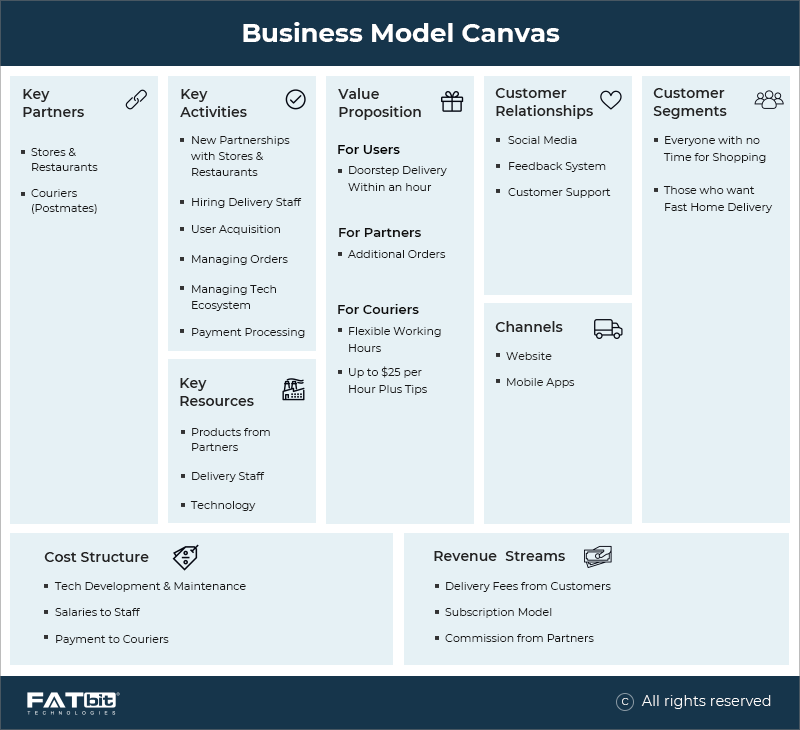
Ecosystem of Postmates- Hardware, Software, and Application Requirements
The pioneering ecosystem of Postmates, which consists of hardware, software, and application solutions provides a compelling experience to its users. It includes –
1. Restaurant POS System Integration
A Point-of-sale system is used by restaurants to store data and ease order management. When an order is placed by a user through the application of Postmates, it automatically appears on the POS system of the restaurant. Further, a two-way integration makes the merchant’s workflow easier with:
- Simplified inventory tracking
- Simplified order management
- Ease of accounting
- Lastly, a restaurant’s menu can be synced and managed directly from POS
2. Kitchen Display System (KDS)
KDS is used to communicate orders clearly in real-time. The order is sent to the kitchen as soon as it has been received. It keeps track of turnaround time, and orders are color-coded. This helps the staff with order management with what’s ready and what is new. Other benefits of KDS include:
- All-day display and production item counts- Spend more time focused on preparing food than counting tickets.
- Multiple language support- Item names can be customized with different languages.
- Advance prep station routing- Orders can be routed to the correct station, whether it’s delivery, dine-in, or takeout.
- Kitchen productivity reporting- Bottlenecks can be identified by digging into the ticket time.
3. Multiple App Integrations
Food delivery applications often depend on various integrations between multiple applications. These integrations allow users to install and interact with them at the same time. If there is a disparate with multiple application integrations, then it needs to be aligned with back-end data sources to provide users with a seamless experience. UX design acts as a bridge to support cohesive user experience and consolidates the app’s user count. Covered below are the aspects of various integrations.
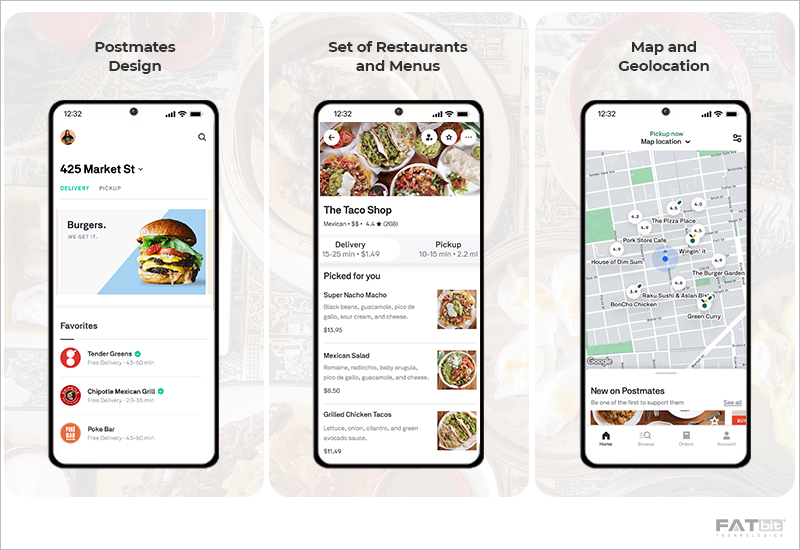
a) Design
The focus of food delivery applications is to transport users to the end goal, i.e. to order food. So after logging in, the design of the application should display a list of restaurants that are popular. Users can choose from the list being displayed or can conduct an independent search according to their preference.
b) Server and API
With the pervasiveness of virtualization, integration of servers and storage has become increasingly important. As a custom food delivery app like Postmates will provide customers with relevant menus and control ordering and delivery processes, it will require a server and a database. The server will facilitate the interaction between users and the application, whereas the business logic of the service provided will be stored in the database.
API integration on the other hand simplifies scaling of food delivery services. If you want to expand to another city or add support to another platform then API integration will provide flexibility. Considering the delivery service of Postmates, third-party developers can embed order functions into the services by using Public APIs.
c) Map and Geolocation
As the food is required to be picked from a particular location and delivered to another location, the app similar to Postmates should be integrated with a map just like the actual app of Postmates. This will help in sending and navigating the pickup and delivery address with the added ability of tracking orders in real-time. By using the maps, customers can track and know the time of order delivery.
d) Payment System
Having a payment system that allows customers to pay directly from the app increases user convenience. Postmates offers credit cards as an option for payment. But, while building an app like Postmates, other payment methods can be integrated. These can be:
- PayPal
- Google Wallet
- Apple Pay
e) Set of Restaurants and Menus
Partnering with restaurants is important to have an app like Postmates, as it is an on-demand food delivery service provider. Requirements include:
- Information regarding restaurants in the city
- Meal names along with their prices
- Meal pictures
The restaurant list can be taken from Google. Menus and photos can be collected from the restaurants. Additionally, menu price changes can be monitored to keep the database updated.
To start with, it is better to launch an online food delivery app in one city, expansion can be considered later. As the application of Postmates is built in a way that in a matter of a few delivery cycles the cost of its development is earned, same can be applied to the new application being developed.
4. Delivery and Courier Management
Postmates believes in empowering retailers to focus on their business by allowing its fleet to deliver products to end customers at any given time. By integrating APIs into their products, big brands including Apple, Walmart, Instacart, and more, are offering delivery experiences to their customers.
Using Postmates as a Delivery Service
- White Label API product for direct client integration and custom app development
- Web App powered by Delivery API – With a click of a button, a Postmate will deliver an order to any local customer, regardless of whether the order was placed in-store, from a website, or over the phone.
Features of Postmates Delivery Service Website
- Real-time price quotes are available when creating new deliveries
- Order can be delivered ASAP or be scheduled to be delivered in future
- Multiple deliveries can be picked up and delivered to multiple customers
- Delivery distance can be set so that the distance is managed
- Multiple location support for more than one storefront
- Tracking links are shareable for retailers and customers to monitor delivery status in real-time, no login is required
- The order can be returned if the customer is not available. The same can be changed to leave items at the door/discard or keep items as per request
Entrepreneurs or businesses can choose any direction with their business plan. They can either integrate an independent functionality to manage delivery, or create a standalone delivery module with integrated APIs. But, empowering local businesses by offering services and resources should always remain the underlying idea.
Bring Efficiency in your Food Order Management
Revenue Channels that Drive Postmates
The mainstay of Postmates has been its revenue model. Strategically planned, it led to Postmates’ massive valuation in the market, thereby outmaneuvering its competitors. Taking an in-depth look, the 4 main revenue streams of Postmates are:
1. Delivery Fee
The average fee charged by Postmates on an order delivery is $5. Nonetheless, this can be reduced to $3 or even less due to ongoing company offers. The total delivery amount is split into an 80/20 ratio. Where 80% of the total delivery fee goes to the courier person and 20% is Postmates revenue.
However, the delivery fee is subject to surge pricing, the same way as Uber during peak hours. Distance, though, is no longer a contributing factor to the delivery charges. But, depending on the basket size, a maximum of $20 can be levied as a service fee.
2. Convenience Fee
Postmates charges a flat 9% as a convenience fee over each order apart from the delivery fee. There is no cap on this fee. To get the orders conveniently delivered to their doors, users happily pay the convenience fee. Unlike delivery fees, the convenience fee is directly earned by the company.
3. Merchant Program
Recently, Postmates unveiled the launch of its merchant program. Where it collaborates with local stores and signs an official agreement. The partnered stores pay a certain percentage of the total bill to Postmates on every order. The sole purpose of this agreement is to earn revenue for the company. Merchants are benefited too as they get an extended customer base.
4. Subscription
Postmates another source of income is via subscription. It improves customer retention and provides the company with advance payments. The unlimited subscription plan of Postmates costs $9.99 a month or $99.99 annually and provides these benefits:
- No peak hour blitz pricing
- Free Delivery on orders over $12
- The order is automatically accepted and moves to the front of the line
The Approach That Will Help to Build an App like Postmates
Market Research
Market research can help in identifying how users might view your business and help in identifying the gaps in customers’ expectations. This information can be powerful for developing a marketing strategy. Good market intelligence helps in minimizing risks while making business decisions. This research can be conducted in two segments. These are:
Staying Up-to-Date with Market Trends
The industry of food delivery is reliant heavily on trends. People are enthralled by popular features. If the app like Postmates is behind these features, customers will move to better applications using the latest technology and trend. Social media integration, smartwatch integration, virtual assistant, among others are a few areas to consider.
Researching Target Audience
The foremost step while building an app like Postmates is to research the target market. Understanding the needs and prioritizing certain aspects like age, nationality, income, and more are pivotal.
Postmates is similar to Uber Eats, with a similar target audience. But Postmates widened its reach by offering to deliver products more than food such as furniture, dishwasher liquid, or a soap bar. This constant supply of small orders kept Postmates running.
Business Model Selection
The food ordering app model depends on the requirements and business goals. The delivery services can be local or global. Mentioned below are various business models of food delivery apps.
-
Order Only Model (Grubhub, JustEat)
In the order-only model, consumers are connected with local restaurants and order their food using the application. This helps in boosting the food order rate of the restaurant.
Using the model, restaurants are entitled to pay fees to the application owner for every order that is received through the app. It can be a setup fee or a commission fee.
A commission fee is a flat percentage of the order cost, regardless of the order amount. A setup fee is an additional fee over commission fee. Using this model, the owner of the food ordering app doesn’t have the quality of food, service efficiency, and more under his control. These are the responsibilities of the food provider. Apps that are focused on orders are primarily restaurant discovery engines.
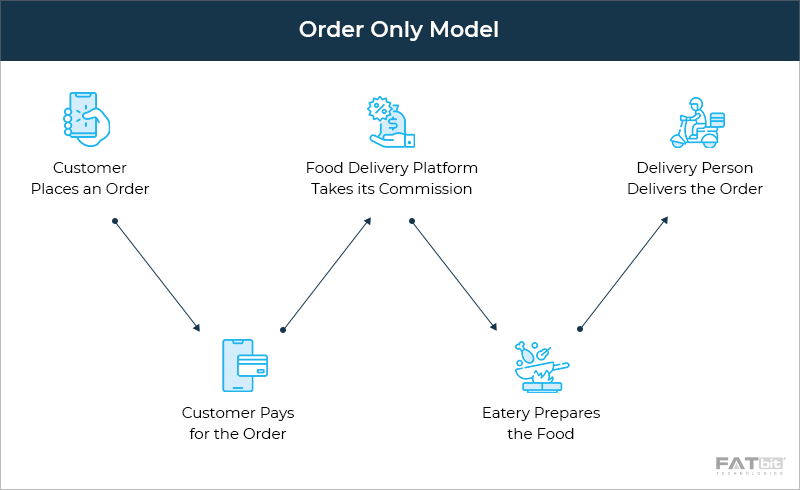
-
Order & Delivery Model (UberEats, DoorDash)
This model provides delivery as a service. The application owner manages the order delivery through the application. Commission and Delivery fee are received from the restaurants on every order purchased via app.
The biggest benefit of this model is that the app owner has control over courier management and the time of delivery. This results in delivering a rich user experience.
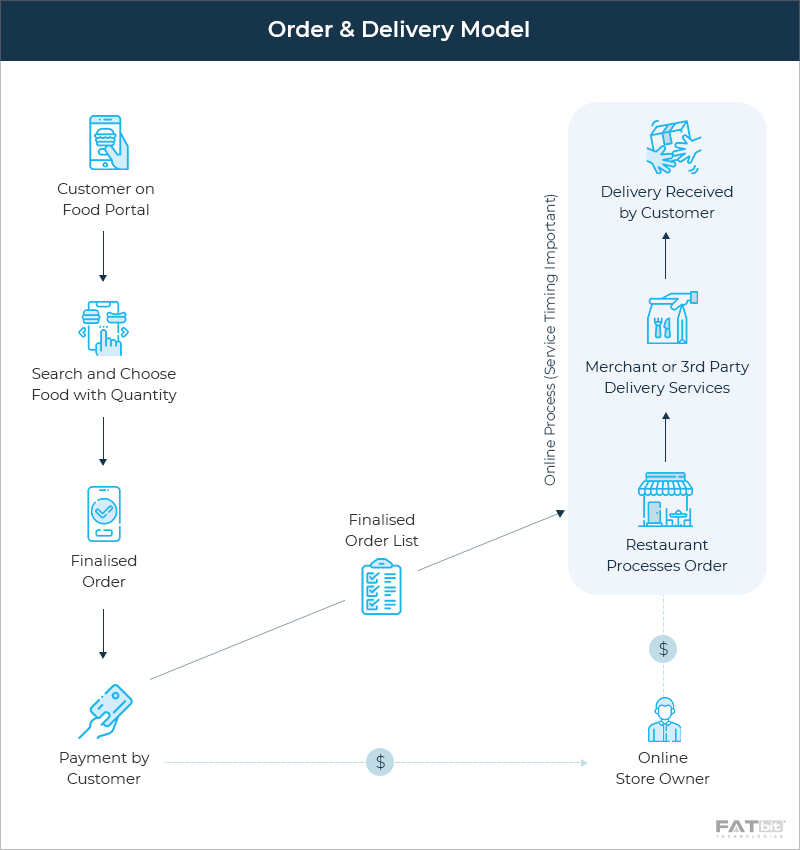
-
Fully Integrated Model (Metabolic Meals, Eat Purely)
This model implies that the application owner has full control over everything in the mobile app, i.e. from food preparation to delivery. Fully integrated models are costly, but the app owner controls food quality, service efficiency, delivery speed, and more. This leads to a higher customer satisfaction rate and consequently more revenue.
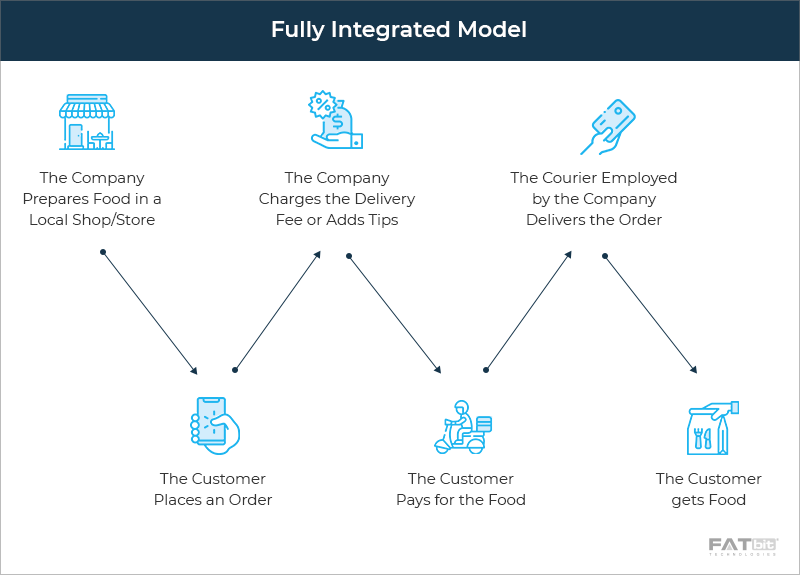
The entire cycle of meal apps aims at making food accessible and delivering it to the customer. Traditionally it was done by phone – where a customer would call the restaurant to order food for delivery. Now food delivery applications look after the process. Moving ahead, let’s go through the features that are important to have while building an app like Postmates..
Features Selection
All food delivery applications come with a few basic features like:
- Registration and Login
- Ordering
- Payment
- Order Tracking
- Reviews and Ratings
But, what if a customer is looking to search for a restaurant or a dish? So the search features will be another vital consideration. Listed below are features for every segment.
| Food Delivery App: Customer Facing Features |
| Registration/Login |
Authorization via email/social networks |
| Card Registration |
Support for multiple cards; Paypal; Apple Pay wallet |
| Automatic Payment |
Automatic Payments via stripe |
| Order Details |
Attach an item picture to the shopping list |
| Pick a Source for the Order (Restaurant or Store) |
Select a store or a restaurant by placing a pin on the map or by typing in the address |
| Delivery Location (destination) |
Select a delivery location by placing a pin on the map or by typing in the address |
| Order History |
See what you’ve ordered previously and easily order again at will |
| Ratings and Reviews |
Leave/see reviews and ratings |
| Food Delivery App: Courier Facing Features |
| Registration |
A courier gets identified and approved by the delivery company before they take on the task |
| Booking an order |
Couriers bid for order |
| Delivery Status |
Set a delivery status: accepted/rejected, picked up, delivered |
| Booking history |
See the history of completed deliveries |
| Food Delivery App: Restaurant/Store Facing Features |
| Admin Panel |
A web-based administration panel |
| Order placement |
Orders can only be placed after |
| Notifications |
Allow users to notify drivers when an order is put in, and notify customers when the order is accepted |
| Payment Menu |
Create and send an invoive to the customer via text message or email |
| Ratings |
Business gets feedback they can respond to |
Other Impeccable Features for Food Delivery Apps:
- Real-time Messenger- An instant messaging feature connecting a customer with a courier is crucial. It can be used to ask for directions, replace items, or more. Placing a call in a busy place can be inconvenient. So approving the changes via a message will make the customer happy.
- Pickup- This feature allows a customer to pre-order so that the item can be picked up later. The feature was first rolled out by Square’s Caviar, it is fresh on Postmates and is expanding its reach.
- Instant Group Deals- This feature is not available in Postmates, but it can make a huge difference in the app like Postmates. Millennials are driven by instant gratification and variable rewards. Finding a random deal that disappears within minutes from the app is addictive. The algorithm is simple:
- A customer initiates a group order from a certain location.
- A timer for order can be set during which other parties can join.
- If a neighbor joins during the validity period, the discount increases.
- In case no one joins, there is no delivery discount.
- A courier person picks up all the orders for a particular neighborhood and delivers them.
- Smart Virtual Assistant- Voice recognition technology allows conversational interfaces to be developed like Siri, which can take voice orders and respond to queries. Smart recommendation engine also allows users to choose meals based on personal food preferences. By analyzing common patterns (flavor or ingredients) it suggests restaurants have meals to suit what the user wants.
Application Variants
A food delivery application can have the following variants:
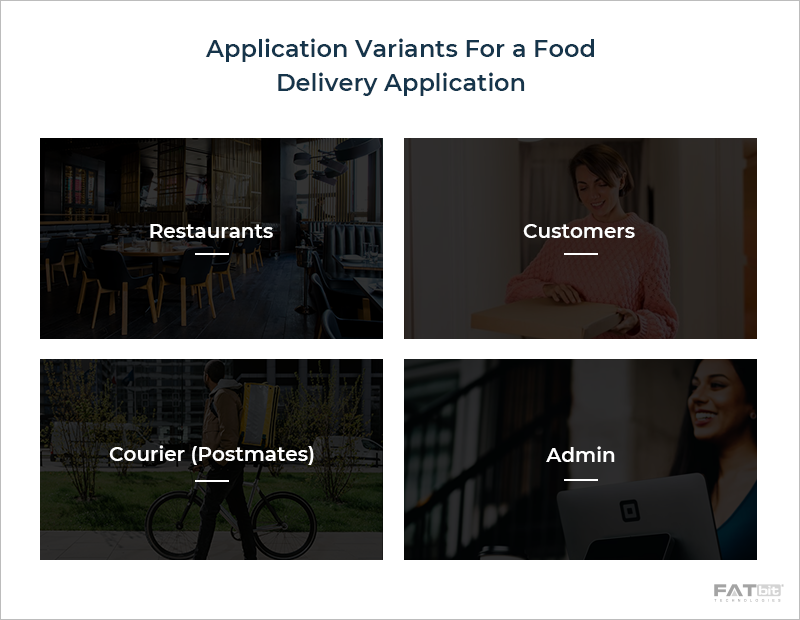
- Restaurants- For better visibility, restaurants partner with online platforms. This gets them extra orders and increases their revenue.
- Customers- Who pay for the convenience of door-step order delivery.
- Courier (Postmates)- Independent contractors who are willing to monetize their extra time for goods delivery. The network of couriers consists of drivers, cyclists, and walkers.
- Admin- Manages the marketplace and earns commission and delivery fee.
Revenue channels
According to different consumption patterns, acquisition channels can be segmented using accurate buyer personas to achieve desired ROI goals. To meet the goals, having diverse revenue streams like advertising, in-app purchases, subscriptions, and more, will sustain and increase business profit.
Technology and Solutions
From the pile of available technologies, frameworks, programming languages, and more, developers can choose the tech-stack for both frontend and backend development.
By using the right technology stack that consists of 3rd Party integrations, solutions can be developed as per client’s requirements. These include:
- Server
- Storage
- Programming language such as PHP 5.4
- Database – MySQL 5.2 or higher
Certain third-party integrations such as social media plugins and multiple payment gateways, can provide better end user solutions. Cloud integration is also a trend these days.
It provides flexibility on how the data is stored, shared and accessed. It is more scalable and has the ability to implement the changes across cloud applications and on-premises systems.
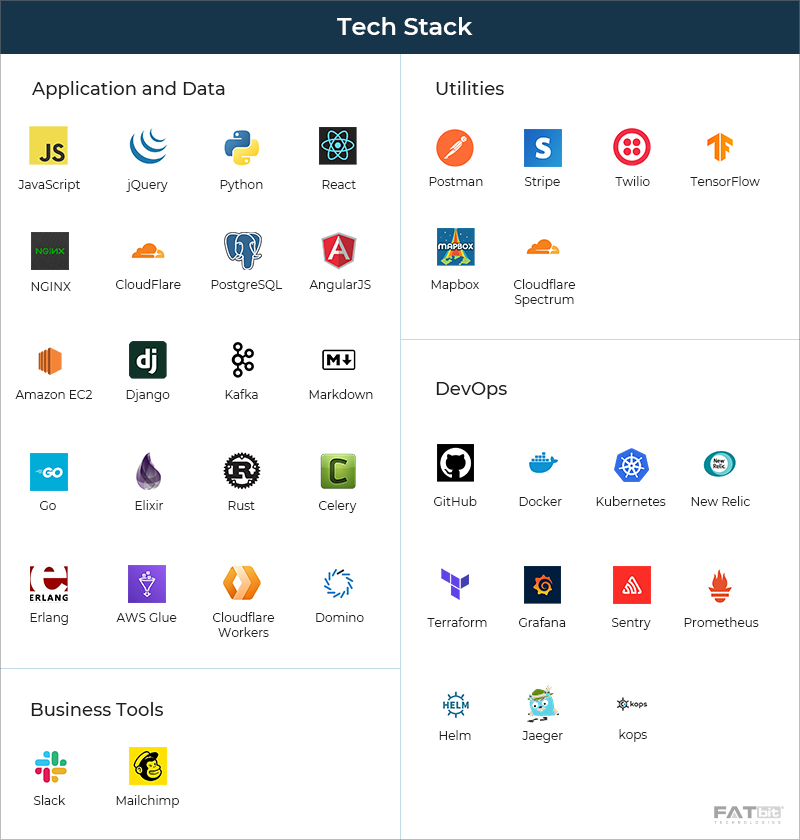
Development and Testing
Once the technology stack for the food delivery app is determined, developers with prior experience in custom app development can be hired. There are two distinctive approaches that can be followed to complete the development of the application. These are:
- Waterfall Methodology- The working takes place in a sequential method with a linear process.
- Agile Methodology- Works on iteration to incorporate time to time enhancements. The work is done in sprints.
After the development of the application, it is pivotal to check for bugs or any functional defects. Requirement matching with the end product is also done during testing. Mobile application testing includes the process to check the usability, consistency, and helps in building an app like Postmates.
Testing can either be done manually, or by automation. Once the application is fully tested and is free from errors, it can be deployed. An application that is fully tested and is error free will provide a good user experience and will eventually boost business revenue.
Launch and Support
Once the application is tested, it can be deployed to appropriate App Stores (Apple, Google, and more) and will be put under production. To make the process of production flawless, testers need to test the application post-deployment as now it is functioning under real-life conditions.
Nurturing and improving the application post deployment is important. While the improvements can be an on-going process, having a team offering support for application performance issues or any other unforeseen situations is crucial.
A dedicated team that monitors, maintains and is available to provide support, will deliver a higher level of trust and an application that operates without any unpleasant performance issues.
Marketing and Promotion
The goal of application marketing is to acquire loyal users that will not only repeat engagements but will also become advocates for the application. If users feel connected to the application, then their word of mouth will broaden the audience.
The early adopters of Postmates spread the word and encouraged people to use the application, setting a trend. This saved 80% of the company’s marketing efforts and led to an exponential increase in sales.
Facebook, Twitter, LinkedIn and other social media platforms are also great tools to market the application. SEO friendly content can be published using blogs to increase the ranking of the application on search engines.
Other social media marketing and advertising tools consist of paid campaigns like PPC, advertisements, subscriptions for premium users, and more. Using marketing tools helps in tracking consumer behavior and aid in increased conversions.
Propositions that Give Postmates an Edge over its Competitors
Postmates has consistently stayed ahead of the curve through its tentativeness toward food delivery. Though its ultimate value proposition is convenience, listed below are other features that provide Postmates an edge over its alternatives:
- Reach New Customers- It helps businesses to expand their local customer base by reaching out to new customers.
- Postmates + Uber Eats- There is an added benefit of being shown to customers on Uber Eats app on partnering with Postmates.
- No Fees or Time Commitments– Download the app and make money whenever you come online.
- Instant Deposits- Get weekly deposits or cash out instantly.
- Well Experienced Chefs- Postmates provides an option to get food from the city’s top-rated chefs.
Other Benefits:
- The menu is frequently updated.
- A nominal fee is charged by the application depending on the distance covered from the pick up to the drop off point.
- The app has a section of special feature stores which gives exposure to specialized stores.
- The food or other products can be delivered from places that do not deliver.
- Businesses that do not want to invest in their own delivery fleet, can expand their audience by signing up with Postmates.
Launch your Food Delivery Business like Postmates
Conclusion
Online platforms are vital for any business in the current times. Learning from the best and taking steps towards creating an app like Postmates will tailor the structure of a business to suit the application market.
Digging into the technological and business aspects is crucial to make informed decisions. Which is why it is important to choose a leading custom mobile app development company like FATbit Technologies to build an app like postmates. Their years of experience will help in developing a robust and scalable app that can help build a broader client base, increase customer loyalty and scale growth.









